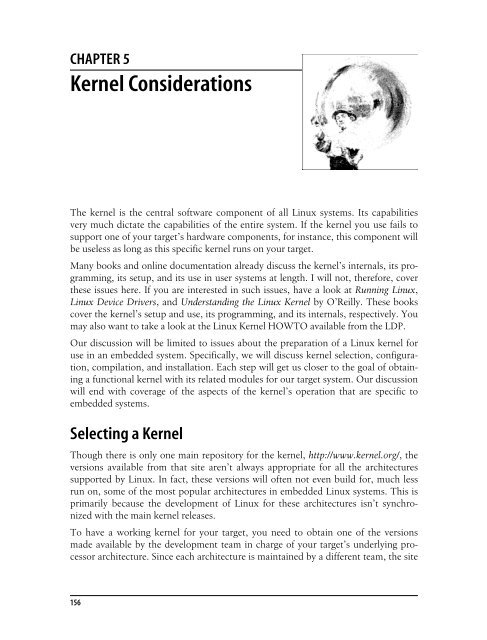Kernel Considerations - O'Reilly Media
Kernel Considerations - O'Reilly Media
Kernel Considerations - O'Reilly Media
Create successful ePaper yourself
Turn your PDF publications into a flip-book with our unique Google optimized e-Paper software.
CHAPTER 5<br />
<strong>Kernel</strong> <strong>Considerations</strong><br />
Chapter 5<br />
The kernel is the central software component of all Linux systems. Its capabilities<br />
very much dictate the capabilities of the entire system. If the kernel you use fails to<br />
support one of your target’s hardware components, for instance, this component will<br />
be useless as long as this specific kernel runs on your target.<br />
Many books and online documentation already discuss the kernel’s internals, its programming,<br />
its setup, and its use in user systems at length. I will not, therefore, cover<br />
these issues here. If you are interested in such issues, have a look at Running Linux,<br />
Linux Device Drivers, and Understanding the Linux <strong>Kernel</strong> by O’Reilly. These books<br />
cover the kernel’s setup and use, its programming, and its internals, respectively. You<br />
may also want to take a look at the Linux <strong>Kernel</strong> HOWTO available from the LDP.<br />
Our discussion will be limited to issues about the preparation of a Linux kernel for<br />
use in an embedded system. Specifically, we will discuss kernel selection, configuration,<br />
compilation, and installation. Each step will get us closer to the goal of obtaining<br />
a functional kernel with its related modules for our target system. Our discussion<br />
will end with coverage of the aspects of the kernel’s operation that are specific to<br />
embedded systems.<br />
Selecting a <strong>Kernel</strong><br />
Though there is only one main repository for the kernel, http://www.kernel.org/, the<br />
versions available from that site aren’t always appropriate for all the architectures<br />
supported by Linux. In fact, these versions will often not even build for, much less<br />
run on, some of the most popular architectures in embedded Linux systems. This is<br />
primarily because the development of Linux for these architectures isn’t synchronized<br />
with the main kernel releases.<br />
To have a working kernel for your target, you need to obtain one of the versions<br />
made available by the development team in charge of your target’s underlying processor<br />
architecture. Since each architecture is maintained by a different team, the site<br />
156<br />
This is the Title of the Book, eMatter Edition<br />
Copyright © 2003 O’Reilly & Associates, Inc. All rights reserved.
















